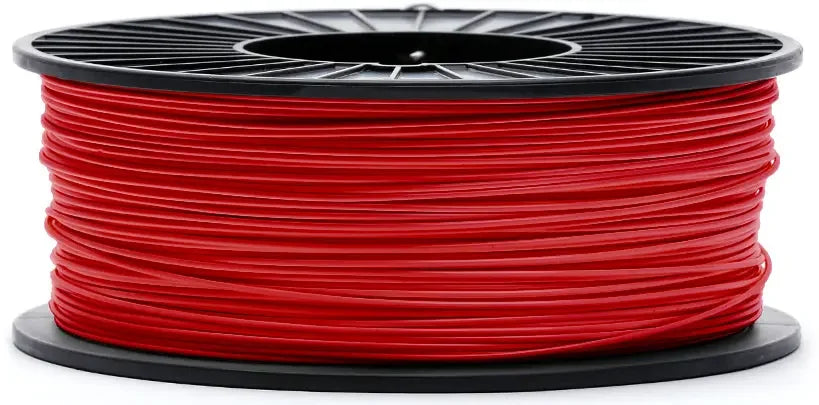
Salsa Red ABS
ABS filament is a thermoplastic 3d printer filament ABS, which stands for Acrylonitrile Butadiene Styrene. It easily molds when heated and sets evenly when cooled. ABS filament is used by a variety of manufacturing industries for parts requiring structural integrity and detail and is ideal for “wear and tear” projects. It is commonly used in rapid prototyping and additive manufacturing environments to test product impact resistance and durability. It is also popular with 3D printing hobbyist who utilize 3D printing in their home or at a local maker faire. This 3D printer filament comes in a variety of colors and is available in 1.75 and 2.85 MM in diameter, and comes in 500 g, 5 lbs, 15 lbs and 1 kg.
As opposed to PLA and PETG filament, ABS is a bit more technical and may be more challenging for new 3D printing users and requires the use of an enclosed 3D printer. ABS is a stiff 3D printing material and it is impact and heat resistant. Common applications for ABS include end-use tools, moving parts, and parts that must withstand high mechanical stress.
Technical Printing Guide - COEX ABS
1. Material Notes
- Keep filament dry - store properly and dry before use
- If needed, dry at 75°C for 3 hours or more
- Enclosure is nessecary
- Use Z-offset slightly higher than PLA (+0.05mm)
- Enable "Avoid crossing perimeters" to reduce stringing
- Consider using the "Wipe while retract" option
- Enable "Slow down for small perimeters."
- Print outer walls slower for better quality
- Use a minimum layer time of 30 seconds for small parts
- Consider using "Extra Prime Amount" after retraction
2. Temperature Settings
Bed Temperature: 80-100°C
- Wash the bed often for good adhesion - Use dish soap and rinse thoroughly to remove oils
- Use bed adhesion products if necessary (gluestick, WELD3D)
- Use brim for tall or large prints
- Keep the ambient temperature stable
Extruder Temperature: 245-265°C
3. Basic Parameters
| Nozzle | Layer Height | Line Width | Volumetric Speed | Temperature |
| 0.4mm | 0.2mm | 0.42mm | 14.0 mm³/s | 250°C |
| 0.6mm | 0.3mm | 0.62mm | 31.5 mm³/s | 255°C |
| 0.8mm | 0.4mm | 0.82mm | 56.0 mm³/s | 260°C |
| 1.0mm | 0.5mm | 1.02mm | 87.5 mm³/s | 265°C |
4. Speed Settings
0.4mm Nozzle (Volumetric Speed: 14.0 mm³/s)
| Line Type | Percentage | Speed |
| External Perimeter | 50% | 83.33 mm/s |
| Internal Perimeters | 75% | 125.00 mm/s |
| Infill | 100% | 166.67 mm/s |
| Top/Bottom | 60% | 100.00 mm/s |
| First Layer | 30% | 50.00 mm/s |
0.6mm Nozzle (Volumetric Speed: 31.5 mm³/s)
| Line Type | Percentage | Speed |
| External Perimeter | 50% | 84.68 mm/s |
| Internal Perimeters | 75% | 127.02 mm/s |
| Infill | 100% | 169.35 mm/s |
| Top/Bottom | 60% | 101.61 mm/s |
| First Layer | 30% | 50.81 mm/s |
0.8mm Nozzle (Volumetric Speed: 56.0 mm³/s)
| Line Type | Percentage | Speed |
| External Perimeter | 50% | 85.37 mm/s |
| Internal Perimeters | 75% | 128.05 mm/s |
| Infill | 100% | 170.73 mm/s |
| Top/Bottom | 60% | 102.44 mm/s |
| First Layer | 30% | 51.22 mm/s |
1.0mm Nozzle (Volumetric Speed: 87.5 mm³/s)
| Line Type | Percentage | Speed |
| External Perimeter | 50% | 85.78 mm/s |
| Internal Perimeters | 75% | 128.68 mm/s |
| Infill | 100% | 171.57 mm/s |
| Top/Bottom | 60% | 102.94 mm/s |
| First Layer | 30% | 51.47 mm/s |
4. Retraction Settings
IMPORTANT: Set travel speed to the maximum your machine allows (200-500mm/s). Faster movements reduce filament oozing time, minimizing stringing.
| Nozzle | Distance | Speed | Z-Hop |
| 0.4mm | 1.0-1.5mm | 40mm/s | 0.2mm |
| 0.6mm | 1.0-1.5mm | 40mm/s | 0.2mm |
| 0.8mm | 1.0-1.5mm | 40mm/s | 0.2mm |
| 1.0mm | 1.0-1.5mm | 40mm/s | 0.2mm |
6. Cooling Settings
Cooling Configuration:
-
- First Layer: 0% (fan off)
- General Printing: 100% base fan speed
- Bridges and Overhangs: 100% fan speed
- Layers < 15 seconds: 100% fan speed
7. Troubleshooting Guide
| Problem | Solution |
| Irregular extrusion |
1. Dry the filament 2. Check the extruder 3. Reduce speed |
| Poor adhesion |
1. Dry the filament 2. Use adhesive 3. Adjust the first layer |
| Stringing |
1. Dry the filament 2. Adjust retraction 3. Increase travel speed 4. Check temperature |
PLEASE NOTE: These printing parameters are initial recommendations based on our experience. They may need adjustment depending on your specific 3D printer, environmental conditions, and the geometry of the part you are printing. Use these settings as a starting point and fine-tune them according to your specific needs.
CX01 ABS Technical Data Sheet
Technical Data Sheet: CX01 ABS SERIES 3D PRINTING FILAMENT
TDS Rev 2.0
BASE RESIN: CHIMEI General ABS POLYLAC Ultra-High Impact Strength
Physical Properties
| Property | Standard | Unit | Typical Value |
|---|---|---|---|
| Specific Gravity - Density | ASTM D792 | g/cm³ | 1.03 |
| Melt Density @220°C, 10KG | ASTM D1133 | g/10 min | 13 |
| UL Flammability Class. @1.5mm | UL 94 | N/A | 94HB |
Mechanical Properties
| Property | Standard | Unit | Typical Value |
|---|---|---|---|
| Tensile Yield Strength | ASTM D638 | MPa | 40 |
| Tensile Modulus | ASTM D638 | MPa | 2350 |
| Tensile Elongation | ASTM D638 | % | 35 |
| Flexural Stress | ISO 178 | MPa | 58 |
| Notched Izod Impact | ASTM D256 | J/m | 285 |
| Shrinkage Rate < 1% | ASTM D955 | mm/mm | 0.40 - 0.70% |
Thermal Properties
| Property | Standard | Unit | Typical Value |
|---|---|---|---|
| Glass Transition Temperature (Tg) | DSC | °C | 105 |
| Heat Distortion Temp @ 0.45MPa | ASTM D648 | °C | 85 |
| Decomposition Temperature | ASTM 3418 | °C | 300 |
SPECIFICATIONS
| Filament Size: | 1.75mm | (in) | 2.85mm | (in) |
|---|---|---|---|---|
| MIN Diameter: | 1.72mm | 0.0677 in | 2.79mm | 0.1098 in |
| MAX Diameter: | 1.78mm | 0.0701 in | 2.91mm | 0.1146 in |
| Tolerance | +/- .03mm | +/- 0.0012 in | +/- .06mm | +/- 0.0024 in |
CERTIFICATIONS
ROHS compliant to (2011/65/EU), 2003/11/EC, TCO'07, Blue Angel and SONY Std. (SS-00259)
NSF/ANSI/CAN 61 Drinking Water System Components
UL/C-UL Certified Yellow Card E56070
Printed Specimen Conditions
| Printer: | Open Source FDM/FFF |
| Nozzle: | 0.4mm |
| Layer Height: | 0.25mm |
| Infill: | 100%, +/-45° |
| Extrusion Temp: | 240°C |
| Bed Temp: | 90°C |
| Specimen Orientation: | XY Flat |
| Unannealed | |
Disclaimer: The technical data contained on this data sheet is furnished without charge or obligation and accepted at the recipient's sole risk. This data should not be used to establish specifications limits or used alone as the basis of design. The data provided is not intended to substitute any testing that may be required to determine fitness for any specific use.
CX01 ABS Safety Data Sheet
Material Safety Data Sheet: CX01 ABS SERIES 3D PRINTING FILAMENT
MSDS Rev 1.0
BASE RESIN: CHIMEI General ABS POLYLAC Ultra-High Impact Strength
1. Identification of the substance/preparation and of the company
660 Corporate WAY
Pulaski, WI 54162
Phone: (920) 757-1055
2. Hazards identification
3. Composition / information on ingredients
3.1 Chemical characteristics:
| CAS # | Hazardous Components | Concentration |
|---|---|---|
| 9003-54-7 | Styrene Acrylonitrile Copolymer | <=95 % |
| 1333-86-4 | Carbon black | <=5.0 % |
4. First-aid measures
5. Fire-fighting measures
6. Accidental release measures
7. Handling and storage
8. Exposure controls/ personal protection
9. Physical and chemical properties
10. Stability and reactivity
11. Toxicological information
12. Ecological information
13. Disposal considerations
14. Transport information
15. Regulatory information
15.1 EPA regulations: This material meets the EPA 'Hazard Categories' defined for SARA Title III Sections 311/312 as indicated:
- Acute (immediate) Health Hazard: No
- Chronic (delayed) Health Hazard: No
- Fire Hazard: Yes
- Sudden Release of Pressure Hazard: No
- Reactive Hazard: No
16. Other information
This data is based on the current state of our information and experience. This safety data sheet describes our product in terms of safety requirements. Preceding data is not applicable as a warranty of product properties. It is the responsibility of the recipient to observe the existing legal regulations for the use of this product.
Disclaimer: The safety data contained on this data sheet is furnished without charge or obligation and accepted at the recipient's sole risk. This data describes our product in terms of safety requirements. The data provided is not applicable as a warranty of product properties. It is the responsibility of the recipient to observe the existing legal regulations for the use of this product.


